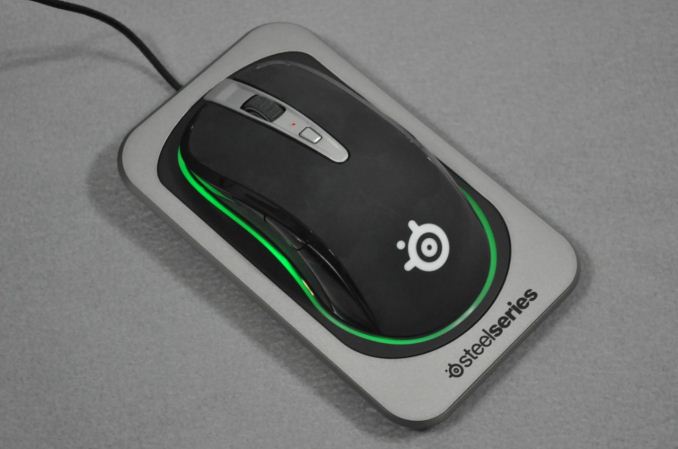Steelseries Sensei Wireless Gaming Mouse Review
by E. Fylladitakis on May 1, 2014 6:00 AM EST- Posted in
- Mouse
- Gaming
- SteelSeries
The Software
SteelSeries obviously tried to keep the software simple and easy to use, as everything is crammed into a single window. The actions of the buttons can be adjusted on the left side of the panel, including the programming/selection of macros. The user can program macros using the keys of the mouse and/or keyboard, as well as adjust the delays between keystrokes, but the macro recorder will not register the movements of the mouse.
The middle portion of the application window let's you adjust the illumination color and effects of the logo and the wheel on the mouse, as well as the ring on the dock. You can select any color you like, as the RBG design theoretically supports 16.7 million colors. As we've mentioned before, however, most of the changes with such lighting schemes are minor at best, and users will typically select from one of about 8-20 primary colors.
On the right section, SteelSeries places a column with all of the settings of the mouse: CPI programming, battery saver settings, sleep timer, acceleration and deceleration sensitivity, lift distance, angle snapping and, finally, the polling rate. The CPI can go up to 8200, a ludicrous figure, as a simple twinkle of your wrist sends the cursor flying across the screen.
Performance and Conclusion
In terms of performance, the Sensei Wireless delivers as promised. We found that the mouse would react perfectly on any surface, including wood, paper, stone, and even glass. A good mousepad however is strongly recommended, not for increased accuracy or anything like that, but simply because it will significantly reduce the gliding effort and will not damage the feet of the mouse.
The Sensei Wireless is very comfortable to use, even if you (like myself) are used to hand-specific ergonomic designs, but it is very lightweight and there is no way to adjust its weight. Some hardcore gamers like to adjust the shape of their mice, which is not possible with the Sensei Wireless. As far as battery life goes, the company promises sixteen hours of battery life; we were able to squeeze nineteen hours out of our sample, about five of them in games and fourteen on desktop use.
While working with the Sensei Wireless, we could see why many gamers liked SteelSeries' Sensei series so much in the past. While it may have a rather simple design, it is very comfortable to use and feels very sturdy as well. We should also remember our veteran mice, as the first and most widely used optical mice were symmetrical. Old habits die hard and we are almost certain that nearly every reader of this article who has seen more than thirty summers, at some point of their lives, has used a Microsoft Intellimouse or Logitech Cordless Wheel Mouse for at least several months. Those that grew up with and are strongly accustomed to the use of symmetrical mice will surely appreciate the comfort and feel of the Sensei Wireless.
On the other hand, the Sensei Wireless is being marketed not simply as a good mouse but as a top-tier gaming mouse. It is very comfortable for prolonged use and the sensor is excellent, while the software offers ample options. However, the Sensei Wireless is also missing quite a few things. While its light weight is very comfortable for prolonged use, hardcore gamers would at least appreciate the option to adjust its weight somewhat. Hardcore gamers would also most likely appreciate more buttons on the mouse, as four (and with two of them placed next to the small finger) might be a bit too few for some.
Nevertheless, these are all but insignificant issues next to the real problem this product has: its retail price. The Sensei Wireless truly is a very interesting mouse, of excellent quality and very comfortable to use; however, with a retail price of $159.99 / €159.99, the competition is tremendous. The Sensei Wireless is priced well over many other very popular wireless gaming mice; in fact, if not for a few Mad Catz products, it would be the most expensive wireless gaming mouse in existence. In many cases you could buy two or even three high quality gaming mice for the price of a single Sensei Wireless - e.g. one for the home, one for the office, and one for your laptop.
To summarize, the SteelSeries Sensei undoubtedly is a very good gaming mouse, but is it good enough to justify such a price premium? That's largely up to individual tastes, so you can decide that for yourselves. Personally, it's difficult to recommend at the current price, and most people would be unlikely to notice any real improvement in their gaming skills. It's a good mouse, sure, but $160 good? For most users, probably not, but there's a niche market of hardcore gamers that might (it's a long shot) be willing to pony up that much money for a wireless symmetrical mouse.
















83 Comments
View All Comments
nekoken - Friday, May 9, 2014 - link
I'm still using my G7 as my mouse on my workstation. It wasn't the best gaming mouse but it is danged accurate and smooth for everything else. I sure would like a wireless replacement that is as good as it is. The batteries are showing their age and only good for a couple of days after many years of hard use.leexgx - Tuesday, May 6, 2014 - link
last time I went on THG was 4-5 Years ago as they getting incorrect results or doing stupid thingsl_d_allan - Thursday, May 8, 2014 - link
Slow week for news? An article about a mouse is the head-line for almost a week?